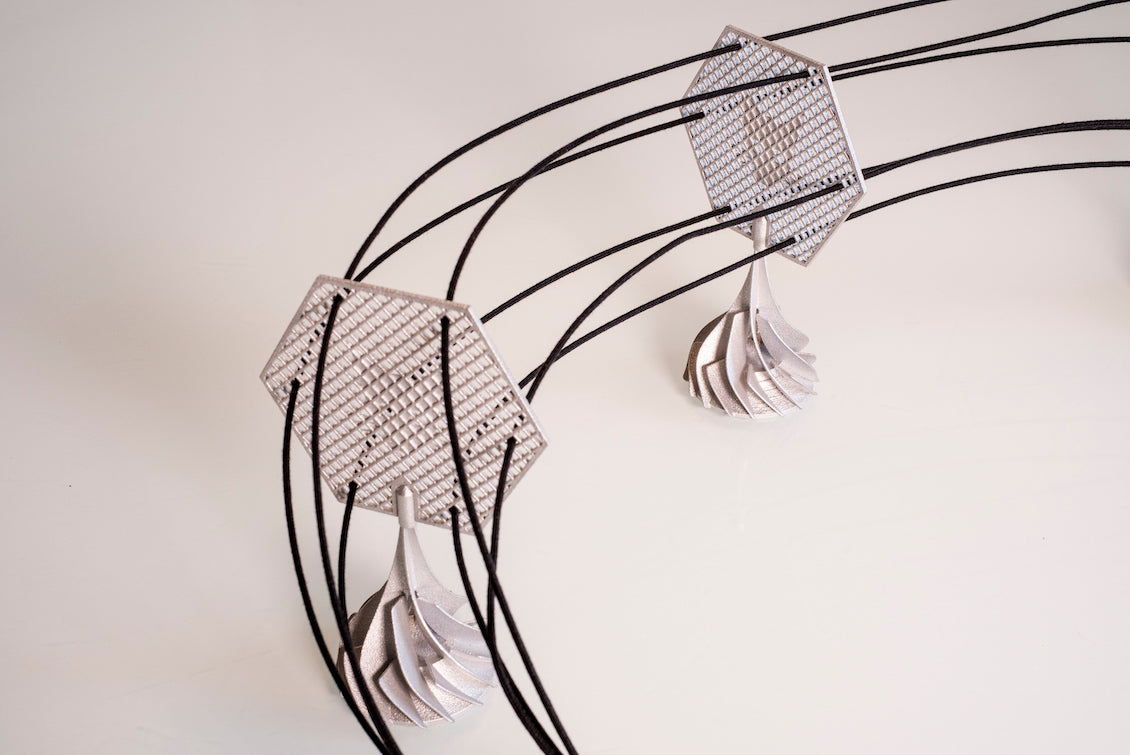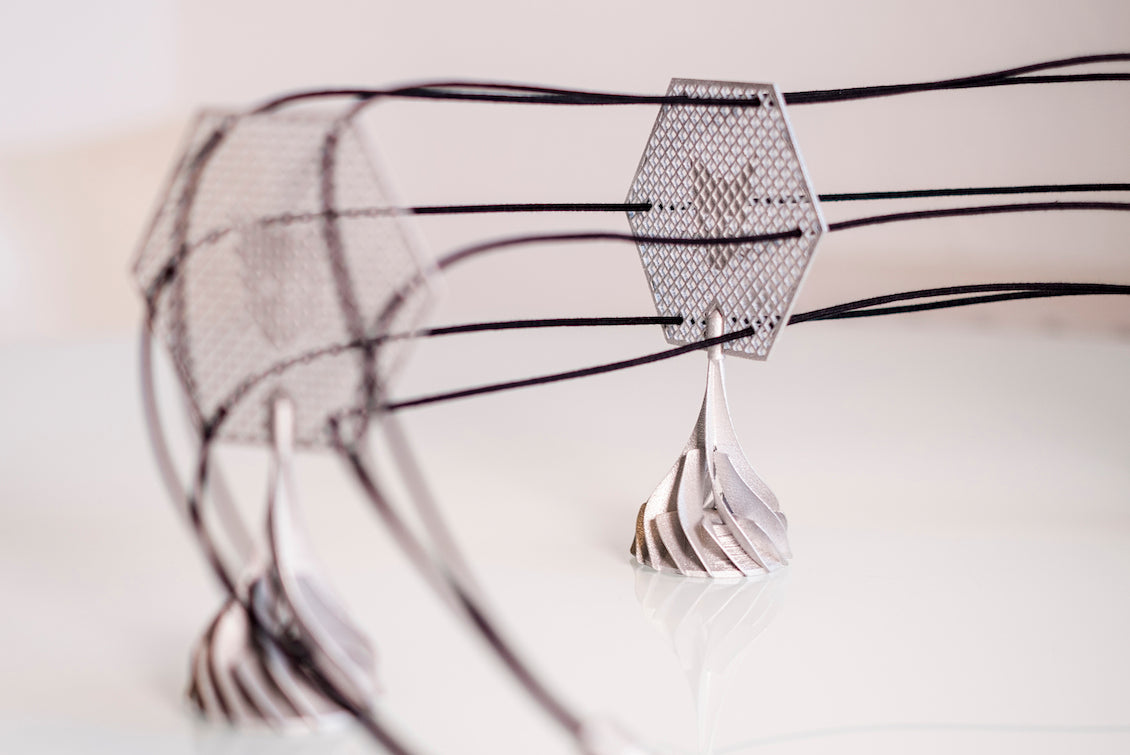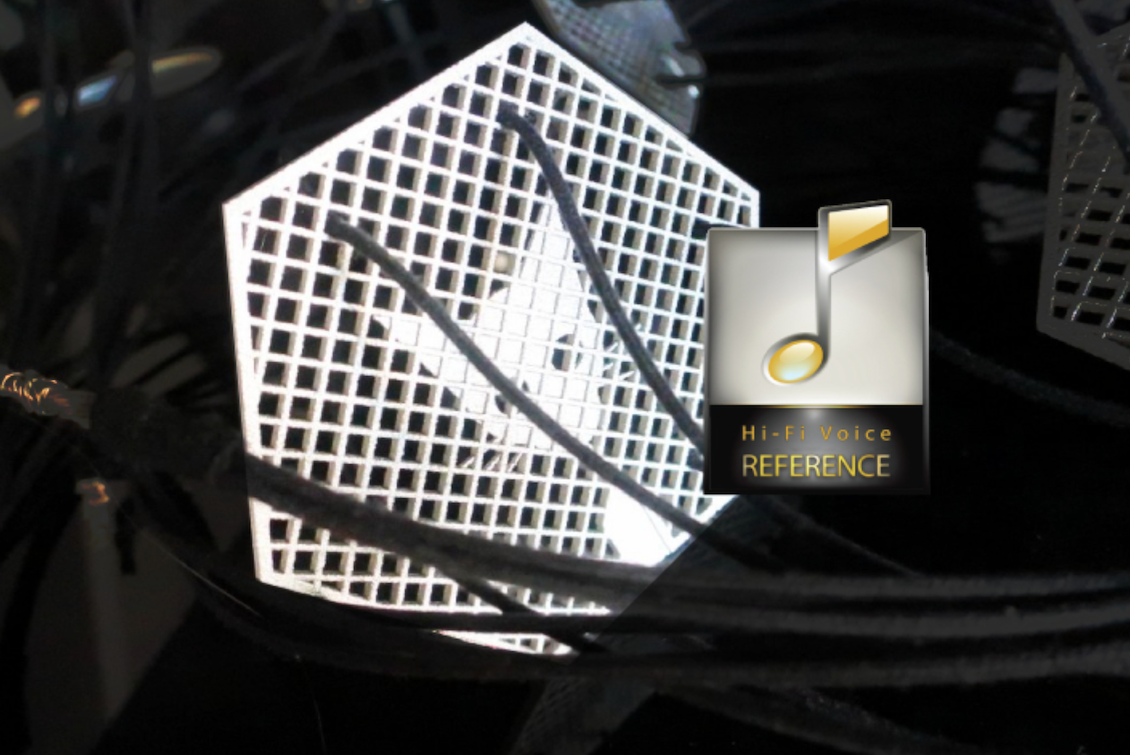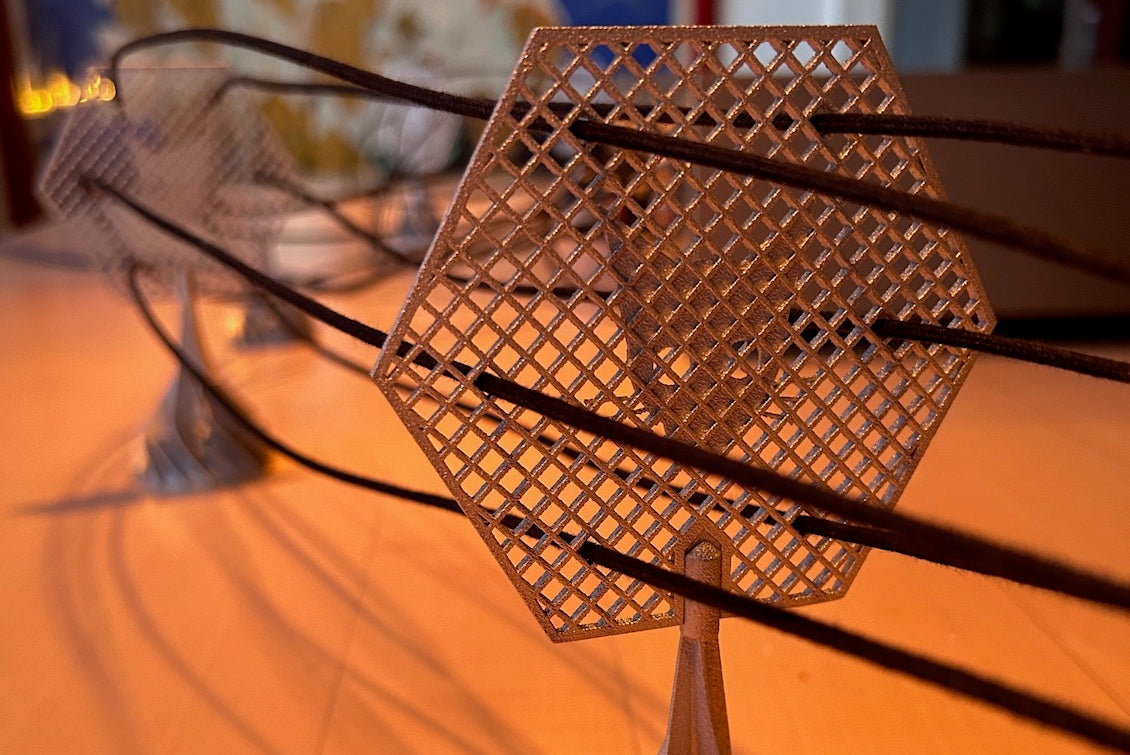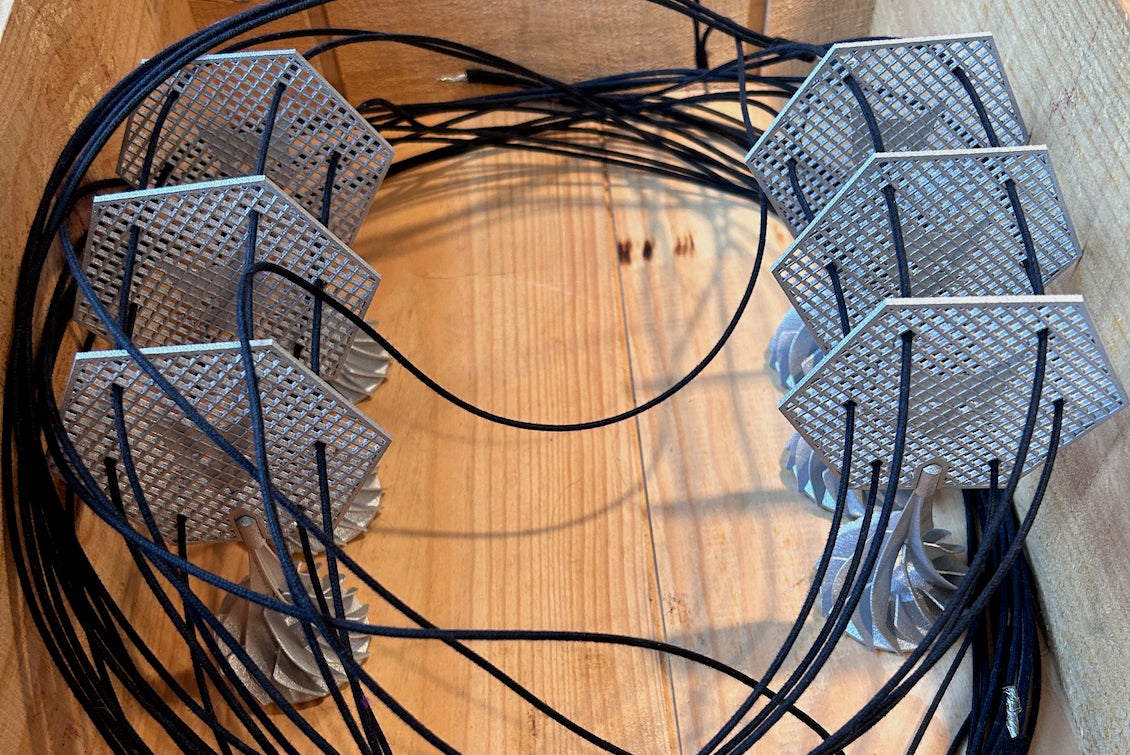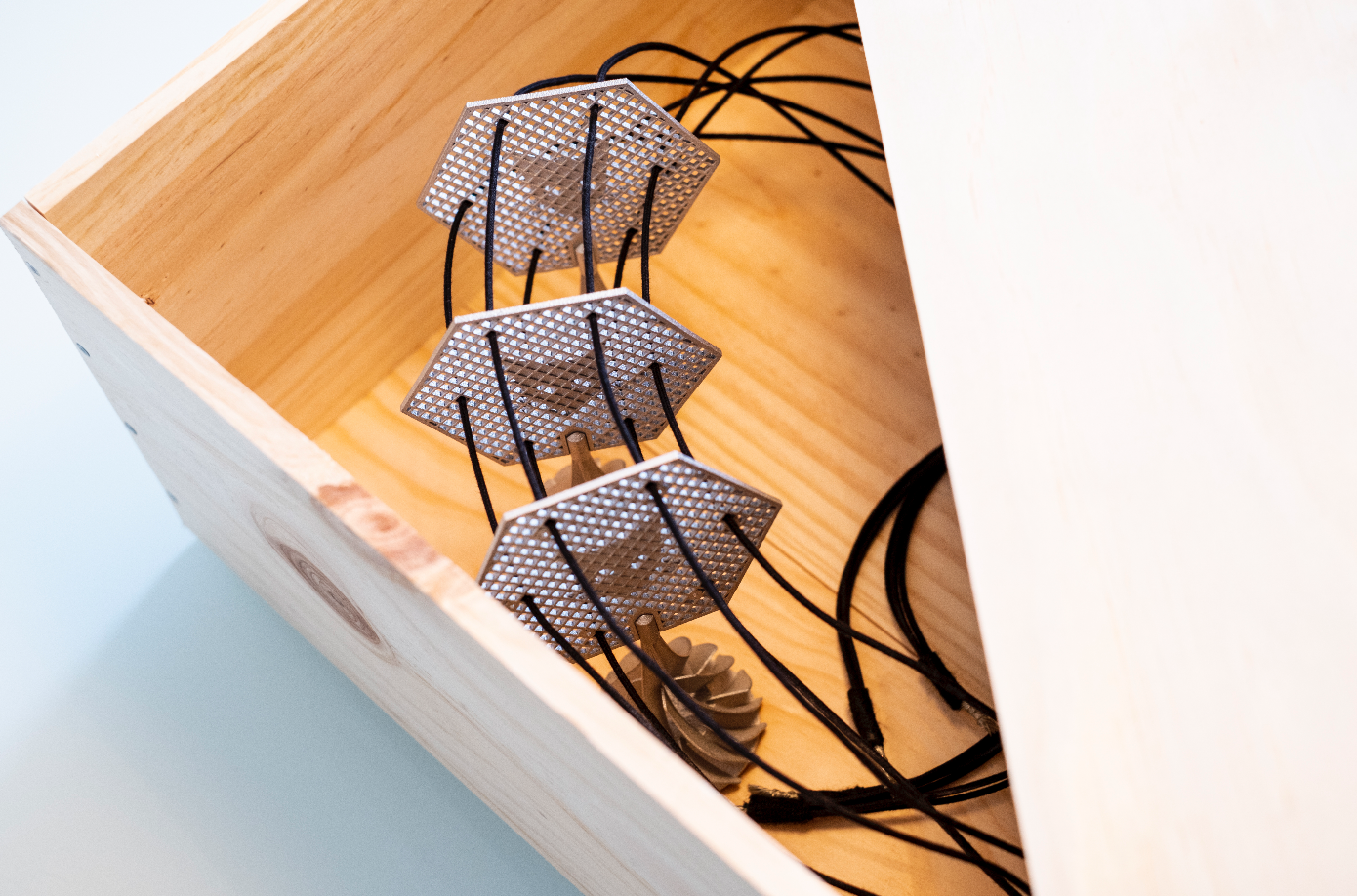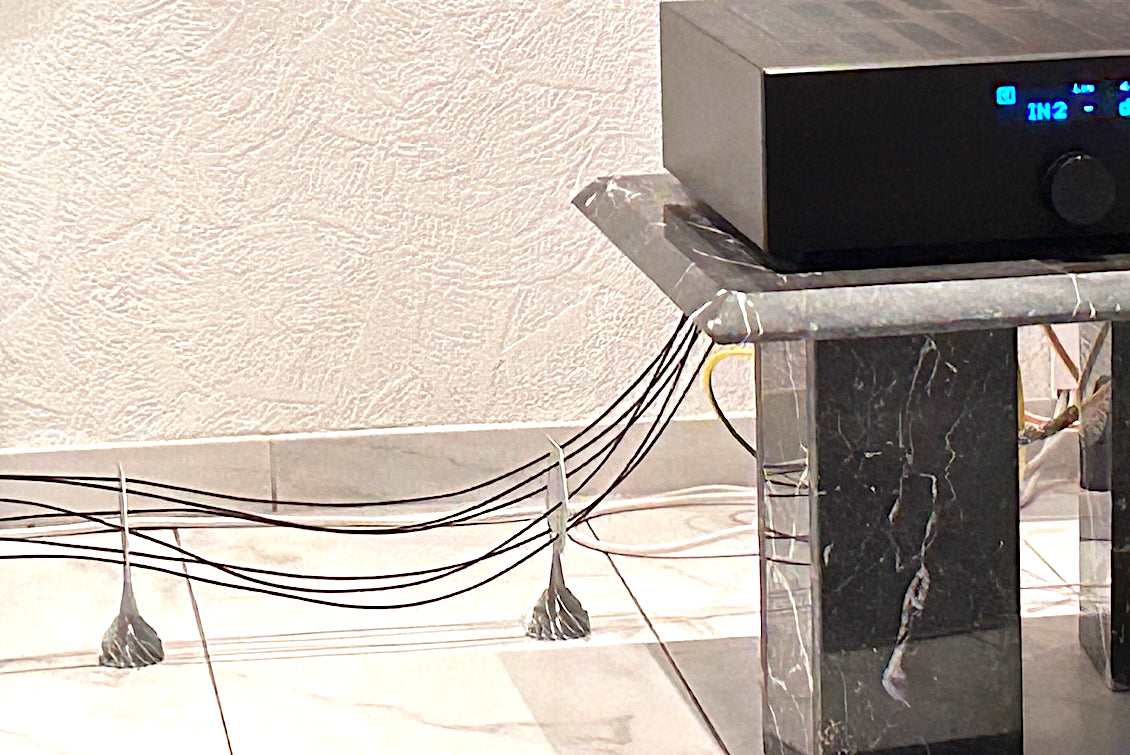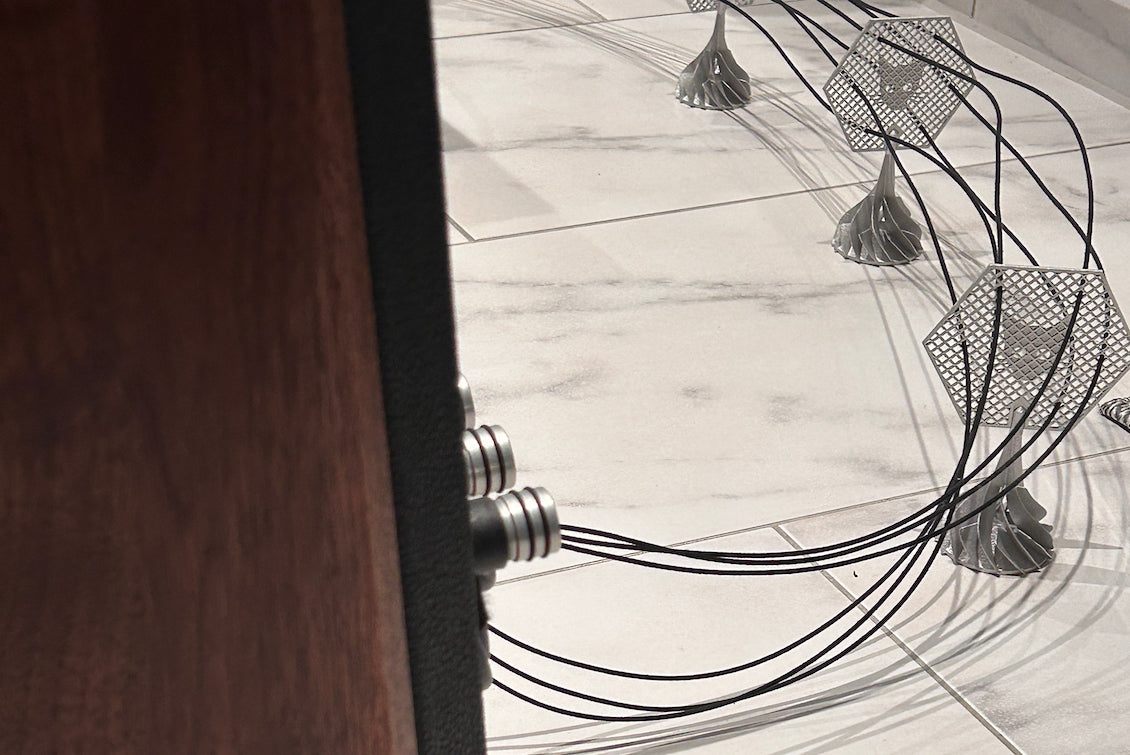Voodoo Labs High End Reference Cabling
VL WITCHCRAFT™ V6 Speaker Cable Grid 2m
VL WITCHCRAFT™ V6 Speaker Cable Grid 2m
Couldn't load pickup availability
WITCHCRAFT™ V6 (patented by the German Patentamt as patent No.10 2023 001 225 and No.10 2023 005 249)
So you always had this uncanny feeling that your set-up with the world’s best audiophile sources, amps and speakers should be capable of more than what you heard. That musicality, luminosity and lightning fast transients were hidden somewhere inside and couldn’t get out.
Guess what, you were right. Introducing the planet’s first speaker grid ("It’s not a cable. It’s a grid.“), WITCHCRAFT.
„Once in a while a product comes along and changes the perspective…what the Voodoo Labs Witchcraft and Carbon Age do to this system is actually jaw dropping…lettings the signals run free of distortions and with lightning speed…all of a sudden the quality of the assorted eqipment rises to another sonic level, showing what they’re really capable of…in the absolute top end for me."“ (Bridging Audio, 3/24)
"It was as if the system charged with energy and was willing to deliver it in an unprecedented amount, while playing both soft and powerful passages more confidently. Non-technically, entirely calmly, utterly relaxed. Like when the sun breaks through the cloud layer or when you finally unwrap a Christmas gift and get inside – it's a more direct contact with what you want. REFERENCE.“
(HiFi-Voice, Czech Republic, 2/24)
„Every now and then, a new audiophile star appears in the sky…when I installed Witchcraft I could hardly believe my ears: It was as if, after decades, the studio door was being opened, and Brian Epstein personally asked me to take a seat in front of the mixing console...it does something in the composition of the played music, in the interplay of the musicians…what sets Witchcraft apart from all other connections between amplifiers and speakers that I know is the ability to present structures in a complex musical event in a natural, unobtrusive, but penetrating way. ...a leap, a revelation, an invitation to rediscover the entire audio archive and experience music in a way that was not granted to you before.“ (HiFi Sound+Music, Germany, 1/24)
length
Pair 2m 9.600.00€ per individual license
colour
Black phases, paramagnetic Faraday Witchcraft stands + grids mil-spec gray
In a nutshell, musical signals ARE NOT TRANSPORTED BY THE TRANSFER OF ELECTRONS FROM AN AMP TO A VOICE-COIL. This is wrong, and the people telling you this have no idea what is happening.
A musical signal is a charge, propagated USING the electrons of the outer shells of atoms as a friendly suggestion where to connect to with light speed. It is called Flux.
Flux happens mostly OUTSIDE a cable or in the outermost millimeter. All what happens deeper inside are vortexes ruining the signal. (If you doubt all this, see Sears/Zemansky: University Physics Vol.II.)
Since we’ve more or less sorted this out in the last three years, starting with our patented and justly famous (Audionet) GAUSS cable lifters („Innovation of the year“ said HiFi Sound+Music) you can now order what we deem to be the first true cable system on the planet.
Invented by our scientists, patents pending, built bespoke by our master craftsmen in Northern Germany. Unique signal quality, literally lightning fast and tonally very very beautiful. Suitable for all High End amplifiers and speakers.
• electromagnetically neutral Flux Optimized Speaker Grid
• additive manufacturing using patented AlMgTy90 mil-spec alloy
• consistently physically separated phases in 6 parallel connectors each
• individual phases pure OFC copper with tin surface
• oiled cotton dielectric
• signal uniquely travels at almost light speed, as per Maxwell’s equation v = c/√(µr × εr)
• 4 valence electrons in the atomic outer shells
• 44 square inch ø EM-field for ideal energy propagation
• scary details, lifelike voices
• sets your amps and speakers free
• patents pending
• open-ended (no terminators)
• minimum internal resistance of approx. 0.0025 ohms/m
• completely hand-crafted in Northern Germany from German and Danish parts
The bespoke cables are individually handmade.
Delivery time is currently approx. 4 days.
Unless otherwise instructed, WITCHCRAFT will be delivered in a fine wooden wine crate made from NIMP 15 certified pine wood from sustainable forestation by the Bordeaux casemaker working for Chateau Petrus as well. Great for storing Jazz records in, too.
IMPORTANT NOTICE: To absolutely minimise the internal resistance we suggest using NO TERMINATORS. WITCHCRAFT does not oxidize, so you can do this without any harm, like worsening the magnetic and electric field constants of a copper-only-cable by a factor of 12-20 through natural oxidation, this is why other peoples cables often sound abyssmal after a year. If that is too scary for you and you INSIST on worsening your numbers by a whopping 30% you can always order excellent Furutech terminators from us and have them installed here, order separately and we will connect the dots.
It sounds only minimally less ideal and still fabulous in comparison to anything else. Thank you for your understanding.
If you happen to do not like the Witchcraft, you can send them back within two weeks from arrival, no questions asked. Hasn’t happened until now, but who knows, maybe you’re a first.
More information and special lengths on request: info@voodoolabs.org or +4940485535
Always happy to help and chat with fellow audiophiles.
For reviews in full text, scroll below the German copy here:
—
—
Read Daniel Brezina, Editor-in-chief, HiFi-Voice, Czech Republic, in his review of WITHCRAFT in 2/24, full text:
The hi-fi realm is full of peculiarities, often bordering on esoterica (there are other possible names for it, but let's stick to the polite ones). When a company decides to name itself Voodoo Labs and christens its flagship product Witchcraft, maintaining a serious demeanor is not easy. However, the main developer here is Jan Geschke, a man who has been working for the Dynaudio brand since 1990 and has consulted for companies like Burmester, PEAK, Dali, NAD, and Audionet. The last of these uses his licensed cable carrier construction under the name Gauss. Based on this idea and its physical principles, the Witchcraft loudspeaker cable project was born – although the point is that "it's not a cable but a transmission system."
Geschke states that practically all cable constructions (both signal and speaker) on the current market are "somewhat wrong" because they do not consider how the signal transitions from the amplifier to the speakers. This is not about the "flow of electrons," as is often said – particles certainly do not flow anywhere; electromagnetic fields are at play here. According to Voodoo Labs, it requires adequate space. In other words, hanging cables in the air so that they do not touch ideally anything, but definitely nothing wooden or metallic.
Witchcraft is a system of stands made from a specifically developed material by the manufacturer, and hexagonally shaped grids attached to them. Through these grids, three conductors for each pole of each channel are led at a sufficient distance (six cables to the right, six cables to the left). No connectors because they supposedly increase transition resistances by at least 30%, somewhat negating the overall purpose of the construction. A specific cotton braid is used because it has the best dielectric properties in combination with plenty of air around. No shielding, as it introduces additional unwanted interactions into the transmission, and Voodoo Labs claims they have never recorded any measurable impact of air-propagating waves through listening or measurement. Pure copper with external tinning is used because it simply has suitable transmission properties for the electromagnetic field, better than the most expensive other metal or a more complex alloy.
The point of the chosen (and patented) arrangement and composition in many experiments is to maintain an unaffected magnetic field, ensuring perfect signal transmission from the amplifier to the speakers. Unlike classic cables, Witchcraft has a significantly larger effective cross-section (from an electromagnetic perspective) - a full 44 square inches, or 284 cm2.
The goal is to "liberate" the connection between both end elements of the hi-fi chain from commonly occurring undesirable influences and disturbances. At the same time, there is an absolute minimization of internal resistance, capacitance, and loss. Due to the construction principle, there is also no risk of microphonics.
Voodoo Labs further states that since the signal travels 95% in the dielectric and 5% in the upper 1mm layer of the cable, the chosen cross-sections and the concept open the way for it. They also refer – somewhat in line with the name of their company – to an understanding of the harmony between the constant magnetic field of the universe, the dielectric constant of matter, and the behavior of valence electrons in the atoms of materials. According to them, thick cables inside (under the mentioned millimeter-thick upper layer) carry only electromagnetic field swirls and, with them, undesirable transmission influences. Therefore, it is not desirable to use a "thick hose."
Everything is handmade in Germany from German and Danish raw materials. A specific metal alloy, defined by Geschke based on experiments, is used for the production of stands and grids, with the help of an industrial additive laser, followed by a lot of manual work.
Voodoo Labs does not provide specific technical parameters, stating that they can be misleading if the context and physical properties and necessities are not well understood. However, they mention minimized internal resistance and capacitance, which, they claim, surpass anything else on the market.
We primarily listened to Witchcraft as part of the main editorial setup, comparing it with Nordost Heimdall 2. The rest of the chain consisted of IsoTek V5 Sirius, Métronome DSC, Norma Revo SC-2 LN, and Norma Revo PA 160 MR, with listening done on KEF Blade One Meta. It was connected with a mix of Nordost Valhalla 2, Nordost Heimdall 2, and KrautWire Super Symmetric Gold cables.
We also tested the stands as supports for the speaker cable (since the shape and termination seem to suggest it), and it must be said that a difference was noticeable compared to Nordost SoftLift – there was added focus and detail, but also hardness and brightness.
Nordost, known for its fast and precise cables, delivered a salvo of bass tones in the eponymous track "Gentlemen" (The Afghan Whigs | 1993 | Elektra | 0075596150125) with a somewhat more resonant, full, but also more coherent manner. The introduction of Witchcraft acted as a catalyst, evolving the sound and making the bass guitar rebound as if it had jumped off a kicker, the tones stood out, but in a completely effortless way that might not be immediately appreciated. If the bass was characterized by something, it suddenly acquired a smooth, unstressed bravado, simply floating, swaying, and rhythmically pulsating with a confidently outlined structure. The balance of frequencies – a certain emphasis on low rhythmic frequencies chosen by the sound engineer to enhance the rock impact – remained unaffected, just as the bass did not harden or transform into an entirely different style. It just became better, more audible, intensifying the amplifier's and speaker's character, and the source of the signal, somewhat more intensely and much, much more easily.
This also applies to Grace Potter's vocals in "Love is Love" ("Daylight" | 2019 | Fantasy | 0888072117396). It was clear, placed more forward, better separated from the instruments, and more specific than ever. Moreover, it seemed that all mechanical aspects disappeared – Anglophone nations like to call it "easy flow," and the Czech term "fluidity" doesn't quite cover it. The recording sounded light, simple, lively, yet harmoniously calm and kind. Grain and hardness, typically present in higher midrange frequencies, were lost. Suddenly, there was a significantly greater inclination to listen, immerse oneself in the music, and enjoy it. Going back to Nordost resulted in a flatter, somewhat recessed voice and an overall presentation as if you reduced the gas and the desire to play.
KEF Blade One Meta can showcase the highs in "Moon Song" by Cécile McLorin Salvant ("Ghost Song" | 2022 | Nonesuch | 0075597914672) very beautifully and informatively even in the standard configuration. However, connecting Witchcraft brought a plethora of new subtle details, a significantly more specific view of cymbal textures, and a sense of a clean yet refined and cultivated reproduction. It felt as if there were more of them, but the best part was undoubtedly the feeling of an exceptionally concrete localization of individual sounds and their amazing presence. Here, it accelerated as if something finally "clicked," and the reproduction became terribly easy, truly and entirely natural, and almost tangible.
Wagner's "Die Walküre" (Leonie Rysanek / Karl Böhm / Bayreuth Festival Orchestra | 1997 | Classic CD | 81) truly breathed dynamically through Witchcraft. It was as if the system charged with energy and was willing to deliver it in an unprecedented amount, while playing both soft and powerful passages more confidently. Non-technically, entirely calmly, utterly relaxed. Like when the sun breaks through the cloud layer or when you finally unwrap a Christmas gift and get inside – it's a more direct contact with what you want.
Especially interesting was how the reproduction seemed to "relax." Pianos and guitars in "Eclipse" ("Dream House Quartet" | 2023 | Deutsche Grammophon | 00028948588329) were occasionally recorded more vigorously, but more resonantly and distinctly – or at least that's how it seemed to us. Witchcraft allowed each of the four instruments to sound more specific, perhaps because the sound is faster, and the control of speakers, thanks to the minimal "obstacles" along the way, is better. At the same time, it felt smoother, without a trace of hardness or, rather, frugality. Of course, you perceive that keys and piano hammers or string metal are not entirely soft sounds, but they still seem incredibly easy and pleasant. The readability of each tone was light, everything had order and organization. Going back to Heimdall 2, which is by no means uninformed, felt a bit like closing doors and leaving the recording studio, hearing the music behind – not unintelligible but still "further away."
Thanks to that overall impressive presence, or perhaps more accurately immediacy, it seemed that Collins's "You Can't Hurry Love" ("Hello, I Must Be Going!" | 1982 | WEA | 299263) was significantly clearer and brighter. Not more exposed or emphasized, just clearer, shown more plastic and more concrete, somehow closer on a larger scale. Perhaps the presence that Witchcraft offers comes truly from enabling amplifiers to interact faster and more easily with speakers; in any case, it really works.
And why is Witchcraft truly an interesting cable/non-cable, was also demonstrated by the radio-dance track "Help Yourself Out" by the energetic South French band Hyphen Hyphen ("C'est la vie" | 2023 | Parlophone | 0190296150043). Its rhythm was emphasized and refined, yet the focus leaned more towards a swaying drive than any urgency. It was as if Witchcraft could distill the sunny charm from the essence of the recording - so many sounds, so much energy, and such good form. You can simply revel in what your system can do and how easily it handles playing. Suddenly, a lot of joy enters your listening room, which may not have been there for a while, and everything feels like it loosens up and improves your mood.
The cable (or, to maintain etiquette, the transmission system) Voodoo Labs Witchcraft may look bizarre and certainly is not for the faint-hearted, however, it managed to bring "something extra" into our usual listening setup that even the most ardent denier of any cable influence would have to acknowledge. The amplifiers seemed to grip the speakers like transducers more firmly, the music flowed more effortlessly, precisely, flexibly, and naturally - poetically speaking, with Witchcraft, the listening experience was significantly more emotional and spoke directly to the soul. It lost the technical elements and "lit up." Despite its name, it doesn't invent any magic or spells. On the contrary, it disrupts many established high-end procedures - no cosmic materials, no complex shielding or polarized dielectrics, and no ultimate connectors. None of that is present here, and evidently, it doesn't matter. The concept, flipped on its head in this way, works exceptionally well, except for when you have to reconnect the cable occasionally because the absence of connectors and the need to keep individual strands apart require a bit of care and patience. But Witchcraft can gift your setup with openness, musicality, and a captivatingly positive "ease," making you listen to everything with a significantly broader smile and joy.
Read Joachim Pfeiffer, Editor-in-chief, HiFi-Voice, Czech Republic, in his review of WITHCRAFT in 2/24, full text:
Engaging with every product in the realm of High Fidelity is always a challenge. The aim is to convey something new to the reader without repeating oneself or contradicting what has been said before. It requires finding memorable words that provoke thought and perhaps lead readers to reconsider their own approaches, making them willing to invest in recommended products. Not in all cases, often it suffices to fulfill the duty of a chronicler: "Look, a new device, a promising accessory, I tried it, it works, or: it works under certain conditions." That it explicitly doesn't work is almost never written in the lines and rarely in between. Since everything somehow promises an acoustic advancement, the real, the genuine, the one that will be talked about for years, largely remains unrecognized. That's what I report.
Voodoo Labs presents 'Witchcraft,' an innovative system for connecting amplifiers to speakers. The fact that it has been patented demonstrates that the manufacturer takes their invention and work seriously. Voodoo Labs has proven this not least with an extraordinary sound tool that elicited headshakes from the uninitiated but enthusiasm from sincerely enlightened listeners: the patented cable spacers called "Gauss.“
'Witchcraft' builds on this idea and uses the same material as 'Gauss.' However, it is not a cable stand but a systematic mesh through which six cables per speaker (three for plus and three for minus) are threaded. At the end of the cables, there are no plugs or spades, as these, according to head developer Jan Geschke, would only compromise the sound. Instead, the cable ends are simply twisted and tinned.
This surprising simplicity shows that real progress sometimes lies in reduction. This underscores Jan Geschke's approach: quality and effectiveness take precedence over visual appearance. It is not wrong to approach Witchcraft skeptically; however, it is wrong to consciously close your ears and hide behind mathematical calculations. This applies not only to the world of Witchcraft but also to many aspects of High Fidelity. Why shouldn't something that seems impossible still exist?
In recent weeks, some older Beatles songs with a revitalized sound have been released. This includes the so-called Red Album of the Fab Four with their early hits. "Love Me Do" is one of these songs. What makes this little song special: it is widely known and has been played countless times with a variety of technical means. Some may have even heard it over their parents' old tube radios. Personally, I found the remix on the first listen quite unspectacular. Perhaps the early works of the Fab Four sound a bit more detailed... That I got closer to John, Paul, George, and Ringo in the studio through the remastering? No, not really. However, that changed abruptly when I installed Witchcraft and could hardly believe my ears: It was as if, after decades, the studio door was opened, and Brian Epstein personally asked me to take a seat at the mixing desk. Suddenly, all recordings of the Red Album sound unusually authentic. Close your eyes... and you see John Lennon right in front of you, he smiles at you, you smile back. That's what HiFi can do, that's why we share the most beautiful hobby on God's earth.
A few days ago, I discovered the carefully researched book "111 Jazz Albums You Must Hear" by Roland Spiegel and Rainer Wittkamp, published by Emons Verlag. The reading is easy, but listening to many of the recommended recordings is a more challenging undertaking. In the era of high-resolution streams, I created a playlist of 990 tracks from this treasure trove, which I could listen to continuously for 3.83 days. In addition to songs that have been favorites of mine for years, the playlist also includes jazz that I always avoided. Have you ever heard the formation "Naked City" with frontman John Zorn, active between 1988 and 1993? "Snagglepuss," for example, from the album "Knitting Factory." So bizarre that you don't quite know whether to laugh, cry, or just play something else. I enjoyed it. With Witchcraft as a mediator. Because what I perceived with "Love Me Do" by the Beatles – the acoustically exciting view of individual voices and instruments that reshape a whole for me – becomes a revelation when venturing into the avant-garde of jazz with rock elements! Speaking of "anger": "What's the anger, my love?" is a track from the "Metropolis" album by the Willem Breuker Kollektief. Another group whose existence I knew but who never took me along, never let me participate in the fun the musicians had during the production of their albums. Thanks to Witchcraft, Willem and his fellow musicians no longer bore me; they inspire me, no longer push me away. "Free Jazz, a Collective Improvisation by the Ornette Coleman Double Quartet": I find myself bathing for the first time in a lake of finely spun sounds, thinking I can look into the faces of the Free Jazzers with closed eyes. It makes me dizzy, euphoric. More of it. Learning more about these people who play only for themselves and a few others. Now also for me? I pause and exchange the speaker connection. Towards the ordinary, the known, the typical cable. Of course, it's still the same music. It doesn't repel me anymore with the conventional cord – because my brain has now experienced a hint of the structure. In search of words or terms that roughly outline the uniqueness of Witchcraft, I take a step further: the strangely shaped system sounds – and everyone will immediately confirm this – wonderfully high-resolution from the first rendezvous, does not omit any details but also does not sacrifice them for the sake of upfront analytics. What sets Witchcraft apart from all other amplifier-to-speaker connections I know is the ability to present structures in a complex musical event in a natural, unobtrusive, but compelling way. With this acoustic tailwind, more is possible, although not everything. Peter Brötzmann, for example, whose "The Complete Machine Gun Sessions" is among the 111 recommendations, remains elusive to me even with Witchcraft – but for the first time, I respect his work because I understand it better.
The familiar becomes more familiar; music I appreciate excites me. "The Last Great Concert" with Chet Baker and the NDR Bigband, recorded on April 28, 1988, 15 days before the death of the gifted musician, touches my heart more intensely than in previous years. Beautiful enough to cry. The talented, broken trumpeter, the sad singer. Suddenly, I am so damn close to the legend that it almost overwhelms me emotionally. Because of a connection between the amp and the speaker? Perhaps. Or maybe I had already done everything right before, so Witchcraft is just the final touch – the confirmation. I disconnect the current power amp, the McIntosh MC 275, and reactivate a rather ugly piece of technology that I have owned for a long time. It wasn't too expensive, but it has always been a loyal companion: The TA 600 from Tannoy, originating from the professional field. The obligatory fan in the discreetly built power amp still bothers me, but the magnificent power development and the "round" sound, not unlike a tube, explain the cult status of the amp built by Lab Gruppen. The TA 600 could never resolve well, and Witchcraft doesn't change that. However, it affects something in the composition of the administered music, in the interaction of the musicians. Not arbitrarily, for the sake of the effect, but because it is obviously defined that way on the recording.
Let's talk about the downsides of Witchcraft. Anyone who is already dissatisfied with their equipment, regardless of the investment amount, is unlikely to find favor in the offering. Quite the opposite, as Witchcraft would certainly point the acoustic finger at the audiophile wound. However, if you already have a great time with your components, even compared to other systems you know, you can dare. Then it will be a step to a leap. A revelation, an invitation to rediscover the entire music archive and experience music in a way that was not granted to you before. With every expensive acquisition, you hoped for it, were certainly not deceived, but surely also often disappointed.
Share

